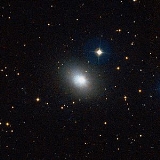
NGC 3077
Encyclopedia
NGC 3077 is a smaller member of the M81 Group
. It looks much like an elliptical galaxy. However, it is peculiar for two reasons. First, it shows wispy edges and scattered dust clouds that are probably a result of gravitational interaction with its larger neighbors, similar to the galaxy M82
. Second, this galaxy has an active nucleus. This caused Carl Seyfert
in 1943 to include it in his list of galaxies, which are now called Seyfert Galaxies
. However, NGC 3077, though an emission line galaxy, is today no longer classified as a Seyfert galaxy.
NGC 3077 was discovered by William Herschel
on November 8, 1801. He remarked that "On the nF (NE) side, there is a faint ray interrupting the roundness." Admiral Smyth
described it as "A bright-class round nebula; it is a lucid white, and lights up in the centre ... between these [stars,] the sky is intensely black, and shows the nebula as if floating in awful and illimitable space, at an inconceivable distance."
s (SBF) distance measurement technique estimates distances to spiral galaxies based on the graininess of the appearance of their bulges. The distance measured to NGC 3077 using this technique is 13.2 ± 0.8 Mly
(4.0 ± 0.2 Mpc
). However, NGC 3077 is close enough that the tip of the red giant branch (TRGB) method may be used to estimate its distance. The estimated distance to NGC 3077 using this technique is 12.5 ± 1.2 Mly (3.82 ± 0.38 Mpc). Averaged together, these distance measurements give a distance estimate of 12.8 ± 0.7 Mly (3.9 ± 0.2 Mpc).
M81 Group
The M81 Group is a group of galaxies in the constellation Ursa Major that includes the well-known galaxies Messier 81 and Messier 82, as well as several other galaxies with high apparent brightnesses. The approximate center of the group is located at a distance of 3.6 Mpc, making it one of the...
. It looks much like an elliptical galaxy. However, it is peculiar for two reasons. First, it shows wispy edges and scattered dust clouds that are probably a result of gravitational interaction with its larger neighbors, similar to the galaxy M82
Messier 82
Messier 82 is the prototype nearby starburst galaxy about 12 million light-years away in the constellation Ursa Major...
. Second, this galaxy has an active nucleus. This caused Carl Seyfert
Carl Keenan Seyfert
Carl Keenan Seyfert was an American astronomer.He is best known for his 1943 research paper on high-excitation line emission from the centers of some spiral galaxies, which are named Seyfert galaxies after him...
in 1943 to include it in his list of galaxies, which are now called Seyfert Galaxies
Seyfert galaxy
Seyfert galaxies are a class of galaxies with nuclei that produce spectral line emission from highly ionized gas, named after Carl Keenan Seyfert, the astronomer who first identified the class in 1943...
. However, NGC 3077, though an emission line galaxy, is today no longer classified as a Seyfert galaxy.
NGC 3077 was discovered by William Herschel
William Herschel
Sir Frederick William Herschel, KH, FRS, German: Friedrich Wilhelm Herschel was a German-born British astronomer, technical expert, and composer. Born in Hanover, Wilhelm first followed his father into the Military Band of Hanover, but emigrated to Britain at age 19...
on November 8, 1801. He remarked that "On the nF (NE) side, there is a faint ray interrupting the roundness." Admiral Smyth
William Henry Smyth
William Henry Smyth was an English sailor, hydrographer, astronomer and numismatist.-Private Life:...
described it as "A bright-class round nebula; it is a lucid white, and lights up in the centre ... between these [stars,] the sky is intensely black, and shows the nebula as if floating in awful and illimitable space, at an inconceivable distance."
Distance measurements
At least two techniques have been used to measure distances to NGC 3077. The surface brightness fluctuationSurface brightness fluctuation
Surface brightness fluctuation is a secondary distance indicator used to estimate distances to galaxies. The technique uses the fact that galaxies are made up of a finite number of stars. The number of stars in any small patch of the galaxy will vary from point to point, creating a noise-like...
s (SBF) distance measurement technique estimates distances to spiral galaxies based on the graininess of the appearance of their bulges. The distance measured to NGC 3077 using this technique is 13.2 ± 0.8 Mly
Light-year
A light-year, also light year or lightyear is a unit of length, equal to just under 10 trillion kilometres...
(4.0 ± 0.2 Mpc
Parsec
The parsec is a unit of length used in astronomy. It is about 3.26 light-years, or just under 31 trillion kilometres ....
). However, NGC 3077 is close enough that the tip of the red giant branch (TRGB) method may be used to estimate its distance. The estimated distance to NGC 3077 using this technique is 12.5 ± 1.2 Mly (3.82 ± 0.38 Mpc). Averaged together, these distance measurements give a distance estimate of 12.8 ± 0.7 Mly (3.9 ± 0.2 Mpc).

